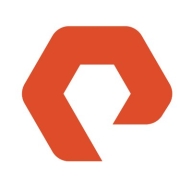


Dell PowerMax and NetApp ASA are leading competitors in the enterprise storage solutions market. Dell PowerMax appears to edge ahead with its advanced NVMe architecture and AI-driven capabilities, but NetApp ASA's effective cloud integration and support system might appeal to organizations focusing on efficiency and customer service.
Features: Dell PowerMax features powerful NVMe architecture, AI-driven automation, and advanced data services, offering exceptional speed and performance. NetApp ASA is notable for unified data management, robust cloud integration, and comprehensive capabilities. While both provide strong performance, Dell PowerMax's speed is a highlight. NetApp ASA's integrated cloud features offer significant advantages for hybrid cloud strategies.
Ease of Deployment and Customer Service: Dell PowerMax provides a robust deployment model with extensive support yet a steeper learning curve. NetApp ASA shines in streamlined deployment processes and exceptional customer support, ensuring easier integration and usability. Both products offer reliable support, but NetApp ASA offers a simpler, more efficient experience.
Pricing and ROI: Dell PowerMax involves higher initial setup costs but delivers considerable long-term ROI with enhanced performance and efficiency. NetApp ASA presents a competitive pricing model, achieving ROI through its comprehensive features and effective management solutions. Despite costs, Dell PowerMax offers value for enterprises prioritizing high performance, while NetApp ASA ensures cost-effective operations yielding strong returns in data-focused environments.
| Product | Market Share (%) |
|---|---|
| Dell PowerMax | 4.6% |
| Pure FlashArray X NVMe | 1.0% |
| NetApp ASA | 2.0% |
| Other | 92.4% |



| Company Size | Count |
|---|---|
| Small Business | 15 |
| Midsize Enterprise | 11 |
| Large Enterprise | 12 |
| Company Size | Count |
|---|---|
| Small Business | 17 |
| Midsize Enterprise | 16 |
| Large Enterprise | 54 |
Pure Storage FlashArray//X is the world’s first enterprise-class, all-NVMe flash storage array. It represents a new class of storage – shared accelerated storage, which is a term coined by Gartner – that delivers major breakthroughs in performance, simplicity, and consolidation.
PowerMax leads in mission-critical enterprise storage with advanced architecture and AI-driven automation, ensuring secure and efficient IT optimization. Its multi-node NVMe scale-out framework delivers unmatched performance and consolidation, backed by Dell’s Future-Proof Program.
PowerMax is renowned for its robust reliability, performance, and efficient data reduction capabilities. Users benefit from its NVMe architecture, aiding significant scalability and cost efficiency through effective deduplication and compression. Unisphere simplifies management, while CloudIQ provides enhanced monitoring. With high availability and strong IOPS capabilities, PowerMax effectively manages demanding workloads and ensures seamless operations. Its compact design and increased storage capacity enhance user experience, particularly with easy maintenance and robust performance.
What are the key features of PowerMax?Dell PowerMax is predominantly employed in mission-critical applications such as SQL, Oracle databases, ERP systems, and high transactional environments. Healthcare, finance, and e-commerce sectors leverage its high performance, scalability, and NVMe technology for low latency and redundancy. It is adept in storage consolidation, data analytics, and disaster recovery.
The NetApp ASA is an all-flash SAN storage array that delivers industry-leading availability, superior performance, and simplified data management across your hybrid cloud. It is designed for a wide range of workloads, including mission-critical applications, databases, and virtualized environments. NetApp ASA features a scale-out architecture that can be scaled to meet the needs of your growing business. They also support a wide range of built-in data protection and data security features, including snapshots, replication, disaster recovery, and autonomous ransomware protection.
Benefits
Features
We monitor all All-Flash Storage reviews to prevent fraudulent reviews and keep review quality high. We do not post reviews by company employees or direct competitors. We validate each review for authenticity via cross-reference with LinkedIn, and personal follow-up with the reviewer when necessary.